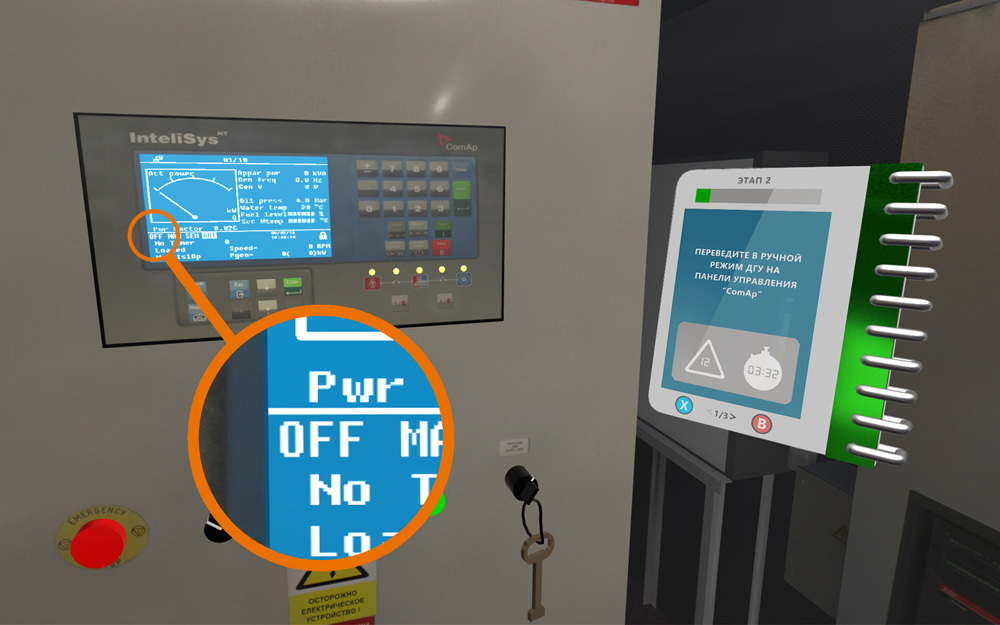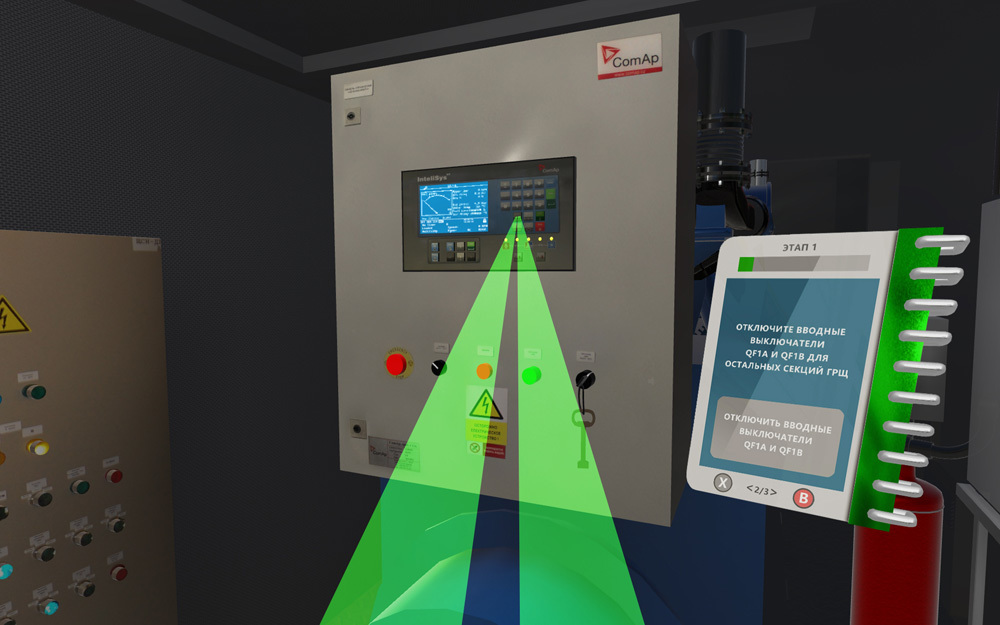Our training rakes in virtual reality (and the problems of engineers with hands on my head)

The story is. There are very few well-implemented virtual reality trainings in emergency situations in the world, except for very, very private content. At all world conferences they show some crap and say that this is a simplified model, or they do not show it at all (since the rights belong to the customer, we cannot show).
We decided to make the maximum possible to work out emergencies in our Tier III data center and caught such a wild number of rakes in a couple of years that we just can’t share.
')
What to show
Before the training, the training for the operation service specialists was based on what they were told with words, where and how the systems are located in the data center, what is their purpose, and the order of maintenance. According to the results of the engineers passed the written and oral tests. The situation in reality is extremely difficult to repeat, especially on live equipment. We took as a basis their method of action and implemented the scenario in virtual reality.
The first step was simple. All cabinets and all guards were copied along with nameplates "do not touch, work is underway" - we started doing this a long time ago, even before the helmets appeared. They began to model without a global understanding of how models are made for such training. Because there was no methodology anywhere in the world at that time.
In the process of implementing the script, we realized that it is not necessary to make models with cog precision, because they will not be visible at all in the learning process. It’s kind of banal, but when you set a task without relying on the script, all the screws with markings on them will be on the DGU. And in virtual reality, everything should be like the present, but with a minimum number of elements. And the screws for screwing the flange are not needed if this is an evacuation training. This is important because when people buy a BP system, they pay for both picture quality and performance. The quality of models affects the requirements for the server, video cards, resolution - a lot of things. In general, it should not slow down. For such things even collect special servers for the order with 72 GPU-cards.
At this moment, by the way, the question of iron arose. Everyone was wondering what it is so expensive for. We quickly figured out. We tried to implement them on desktops with game cards, so it turned out that it was impossible to run a picture in stereo from a professional projector on them. We wondered why clusters for VR are collected from workstations, tried to take a server and shove several cards into it. It became clear that a special train was needed, which is not present in nature, cooling ... In short, there is no need to invent a bicycle. As a result, bought the "right" server.
To a competent preparation of content in terms of performance came to some extent in 2014. For themselves formed the order of development of content for BP. And they tested themselves on the same methodology. An important first step, for example, is not to model and program, but to understand what the training and what equipment is used in the script about; which is critical (maybe it’s not necessary to model cabinets, but an indication light on the ceiling). It is very important that a person sees all things as on a real object, and all requirements are reduced to ensure that the parameters and dimensions of the pixels do not distort the real geometry of the object.
We have, for example, in the training on the data center, the boundary parameter - the engineer from his place at DGU sees the numbers on the screen. So, from the same place in the virtual reality room, he has to distinguish between them - hence the resolution requirements. There are hundreds of such basic elements.

By and large, there are no methods that calculate the display system, if you know the minimum object. They created training in maximum detail, drove into the room - and began to watch what and how. They invited an expert from Compressor (this is the name of our data center) - he looked into the room, put on slippers and glasses. We loaded a model without logic, without a script - in terms of pixel size and resolution, everything seems to be ok.
"I hryat her, she bdyzh and trrrr, I for the switch, and if pff and hrrr-trr-hrrr, then immediately put out"
They began to drive scenarios - the second comment appeared immediately: it is necessary to supplement with sound necessarily. It turns out that engineers are listening to a lot of things, and the sound determines whether the thing is working or not. For example, if you turn on the DGU, the walls should rattle. Shook - only then you go to do the action further. This is very logical, but for a long time it was thought that neither the quality of the graphics nor the sound influenced the effect. Only logic influences. We had the confidence that in order for the sensation to appear, it is necessary to model well.
We drove another big test with the team from the site. They say that the light in the room does not correspond to reality: "It seems to us that the room is darker." And this, by the way, is not only adjusting the picture, but also the brightness that the projector gives. And there are no formulas - you need to understand what power is needed. The same question for helmets. We have to count ourselves.
The next moment - we tried a large number of users (2000 people) in the demo room to give scripts in helmets and rooms. The obvious differences were precisely the emotional plan, because you put something on your head and the possibilities to move freely and interact with others are narrowed down.
Corrected the sound. They completed the display important with light bulbs - that the modeler did not understand, suggested colleagues from the object. Once again we sat with them on the tests - they say everything is cool. And these are people who have actually worked for several years. Feel at home.
Geometry
It is necessary to decide on the geometry of the room: there is a cube, a cylinder and a dome. We stopped on a cube - there are no distortions there, because projectors give a picture on a flat screen. Room on 4 screens - side, front, floor. Sometimes a full cube is used. At the junction of the screens, yes, there will be distortions in the cube - minor, this does not affect the work in the data center. Cylinders and spheres are used in large simulators when you need to be able to look around you without special joysticks. Peugeot and Citroen have rectangular rooms, so it's much easier to maintain them. Without space prices for iron, the following is obtained: they took the model of the international space station and began to reduce the sphere to a segment. Software and hardware tried - you look, and the ISS solar batteries are healthy screw. At the edges especially. On production, it is necessary to evaluate the correctness of the form, and you can take such a special effect as an error. Therefore, only cubes.
Manipulators
To press the buttons in the script, we need normal manipulators. They are not there now. There are all sorts of things from Xboxbox, flysticks-joysticks, but that's all we used to sitting in front of the display. Gloves - no options. When you look at the hand, you do not see the stereo image, when you look at the picture - it is not clear how to capture the image. The tracking system gives an error of several centimeters - this is like a felt boot on the console. There are many places on the model with keyboards or iron control panels - there are small buttons. In an emergency, you won’t think “hop, I’ve hooked it up, now I’ll press a button,” although we’ve been trained by a trembling thing to catch the button first. Even now, the “tremor” is not compensated in any way, it is necessary to write your own finishing touch.


In addition, the engineer, it turns out, does different things with different hands in different directions, but here at first it did not work, he was wildly enraged.
It took a lot of time to figure out how to work with manipulators.
Now they make manipulators for each hand separately. We need to think about how a person interacts with this. We are testing. At all exhibitions we look at manipulators. There is no final decision yet.
Another problem from the field of training of service and operating personnel of technical objects is people with large hands. Some palms can almost have my head. And standard manipulators are not suitable. MIIT, for example, for Russian Railways is also writing a technique for using technology in such cases. Watching them.
Effect
The main question is whether the training has a real effect. Our experts say that gives. We are preparing the training of 11 operators of the data center operation service with this virtual reality system. Changing the script is simple: the model is complete, the scenario for several rooms. Running on the data center with joysticks between the rooms, inside the rooms - kicking the cube. We do not consider the option with tracks yet. Loaded by a pair of master and student.
References:
- Why 3D engineers
- Content shoals
- Iron and body kit
- Difference between 3D and BP
- My mail is ALeus@croc.ru.
Source: https://habr.com/ru/post/306080/
All Articles